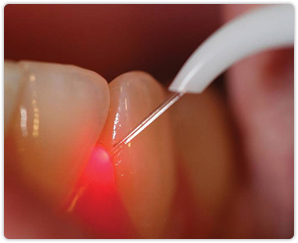Laser Dentistry

Laser dentistry can be a precise and effective way to perform many dental procedures. A laser is an instrument that produces a very narrow, intense beam of light energy. When laser light comes in contact with tissue, laser can remove or shape tissue.
Lasers can be used as a safe and effective treatment for a wide range of dental procedures and are often used in conjunction with other dental instruments.
Benefits of Laser Dentistry?
Here are some of the major benefits associated with laser dentistry:
- Procedures performed using soft tissue dental lasers may not require sutures (stitches).
- Certain laser dentistry procedures do not require anesthesia.
- Laser dentistry minimizes bleeding because the high-energy light beam aids in the clotting (coagulation) of exposed blood vessels, thus inhibiting blood loss.
- Bacterial infections are minimized because the high-energy beam sterilizes the area being worked on.
- Damage to surrounding tissue is minimized.
- Wounds heal faster and tissues can be regenerated.
How does the dentist use the technique of laser dentistry?
The dentists use the hydrophotonics technique which uses the combination of laser energy as well as spray of water that help in performing various procedures on gums, teeth and teeth bones more easily. The laser energy is absorbed by molecules of water present in the tooth tissues. The laser energy causes a explosion because the water molecules expand which in turn moves apart the tooth particle.
How much recovery time is required after laser gum treatment?
Laser automatically forms clots/it seals the blood vessels as well the nerve ending. One can return back to work immediately after the treatment and there is no down time. Hence it is very convenient and comfortable for the patient as there is no recovery time.






